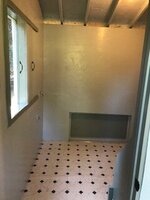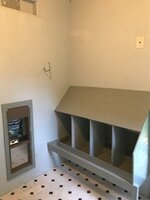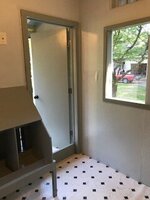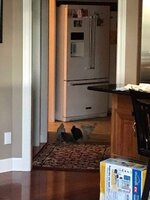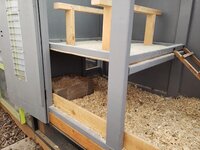I'd go with C then, but you might have to wrangle chicks into the coop at dusk.
Could reduce steepness of ramp by putting half a concrete block, or something, underneath low end.
Could also leave the coop part closed up for another week or so.
Could reduce steepness of ramp by putting half a concrete block, or something, underneath low end.
Could also leave the coop part closed up for another week or so.


 Perfect timing!
Perfect timing!
 ). We will build a brooder under the roosts. The plan is to make a "sleeve" with two 2" X 2" boards on both sides of the coop under the roost bars and slide a piece of plywood between them for the roof of the brooder. (It will be removable when we are finished using it for the year.) Then for the front, we will make a frame and put either hardware cloth or poultry fencing over it and make similar vertical "sleeves" to slide it into for the front. We have a cleanout door on the back of the coop which will be perfect for access to the chick and for food and water. At least, that is the plan for now. What do you think? Do you think that will work? These are our "first ever" chickens. I will attach photos of the coop. (The roost bars aren't in the photo but are right above the clean-out door - you can see the brackets that they sit in.)
). We will build a brooder under the roosts. The plan is to make a "sleeve" with two 2" X 2" boards on both sides of the coop under the roost bars and slide a piece of plywood between them for the roof of the brooder. (It will be removable when we are finished using it for the year.) Then for the front, we will make a frame and put either hardware cloth or poultry fencing over it and make similar vertical "sleeves" to slide it into for the front. We have a cleanout door on the back of the coop which will be perfect for access to the chick and for food and water. At least, that is the plan for now. What do you think? Do you think that will work? These are our "first ever" chickens. I will attach photos of the coop. (The roost bars aren't in the photo but are right above the clean-out door - you can see the brackets that they sit in.)